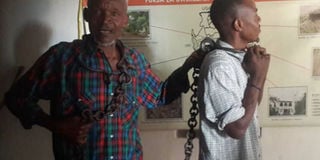Retracing footsteps of Dr David Livingstone

Hamis Kaloka, the caretaker demonstrates how slave masters used to operate at Dr Livingstone’s home in Kwihara.
What you need to know:
- Historic site. He was an explorer and slavery abolitionist who traced the source of the Nile in the wrong direction, LINDA LILIAN explores.
As you walk into Kwihara, this is the place where Dr David Livingstone’s mansion in Tabora, Tanzania endures. The marks of exploration victories intermingled with the pains of a slavery settle in your senses. From the hand written scribbling of David Livingstone, telling of his latest discovery to the wretched sight of the slave yokes and chains used to shackle the slave, the story is reborn.
Tour
The words of Hamis Kaloka, the caretaker of the site, begins to sort out the tale of the explorer and the villain slave master. “When Livingstone was here the slave master Said Salum Mohammed fled,” Kaloka explains. This resonates with the BBC Historic report indicating, Livingstone was inspired to explore by the thought of reaching the interior of Africa and introduce Africans to Christianity as well as freeing them from slavery. Kaloka says Livingstone was able to redeem some slaves including his two servants Chuma, a Tanzanian and Susi a Sudanese, whom he paid TShs5 per month. But the passion to explore took him off the course of fighting slavery and he was often on his feet looking for adventure.
Despite his successes, Kaloka narrates, the British sent out a team to persuade Livingstone to return home. When Henry Morton Stanley and John William Shaw reached Kwihara-Tabora, they found Dr Livingstone had left for his quest to Kigoma, with a notion that there was a link between Tanganyika and the Nile. Perhaps, if he had looked closely at River Kagera entering Lake Victoria and then the Nile flowing to Egypt it would have been easier. Yet the accomplished explorer trotted on as he had made several attempts to discover the source of the River Nile.
In Kwihara
Stanley and Shaw decided to track down Livingstone following him to Lake Tanganyika. But on the way, 20 miles from Kwihara, Shaw fell sick taken down by malaria and diarrhoea. Shaw retreated to Kwihara where in despair he shot himself. His grave stands there attracting speculation about the possibility of him seeking local remedies the African had at the time. Perhaps they looked barbaric dressed in their mini bark cloth cultural outfits.
Stanley was not able to convince Livingstone to return home when they met at Ujiji. After the two paid their respects to their fallen comrade (Shaw) Stanley on March 14, 1872, they left for Zanzibar to await the monsoon winds that would sail him back to his homeland. Livingstone in August 1972 decided to go to Zambia in search of Lake Bangweulu. As he rode on his donkey escorted by Chuma and Susi who moved by foot, he fell ill. The donkey also died presumably of fatigue. His two servants proceeded to carried him all the way to Zambia where he died in May 1873 at Kitabo Village.
Gruesome act
Following Livingstone’s instructions based on his medical background, his servants removed his intestines and buried them in Zambia. Salted his body and dried it in the sun before taking it to the missionary church in Bagamoyo. It was then transported back home. Kaloka says pointing at the old newspapers hanging on the wall with Livingstone’s reports, the body was buried in England because he was popular.
When Livingstone died Said resumed his devious trade capturing the natives and taking them in cohorts of 40 on a 45-day journey to Bagamoyo.
“Often five died on the way, 20 were sold and 15 had to carry goods to Tabora,” Kaloka intimates. Surprisingly Kwihara which was once the home of the missionary doctor and explorer who detested slavery, now became the home of Said and his horror ground.




